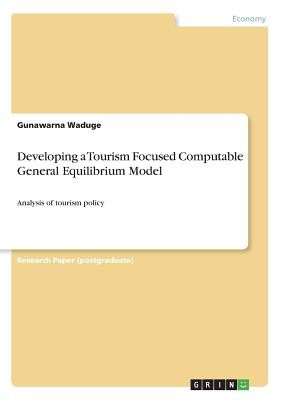
- We will send in 10–14 business days.
- Author: Gunawarna Waduge
- Publisher: GRIN Verlag
- Year: 2017
- Pages: 60
- ISBN-10: 3668496153
- ISBN-13: 9783668496156
- Format: 14.8 x 21 x 0.4 cm, softcover
- Language: English
- SAVE -10% with code: EXTRA
Developing a Tourism Focused Computable General Equilibrium Model (e-book) (used book) | bookbook.eu
Reviews
Description
Research Paper (postgraduate) from the year 2017 in the subject Tourism - Miscellaneous, Griffith University (Griffith Institute of Tourism), language: English, abstract: Conventional literature has proven that Computable General Equilibrium (CGE) modelling is the best applied tool addressing and analysing tourism related issues in an economy. Therefore, the aim of this paper is to develop a Computable General Equilibrium Model for an economy (hereafter referred to as CGE-Tourism) for tourism impact analysis. The core model of CGE-Tourism closely follows the well-known Australian ORANI model and the extension of tourism to the core model closely follows the recent work of Australian tourism modellers. This paper contains six sections. The second section provides a brief summary of economic impact analysis of tourism. Section three outlines the overview of the theoretical structure and implementation of the CGE-Tourism model. The system of equations of the core model of CGE-Tourism is presented in section four. Section five describes the new extension of tourism modelling to the core model. Measuring the contribution of tourism to a national economy has always been a frustrating exercise. Tourism does not have specific products. It represents the sum of expenditure by travellers for wide range of products. It is not possible to identify tourism as a single "industry" in the national accounts, its value to the economy is not readily revealed. As a result of the absence of tourism in official economic statistics, there is often an on-going battle to establish tourism credibility as an economic activity and generator of income in the economy. As a result, a significant volume of tourism research over the past few decades have focussed on the development and use of a variety of economic techniques aimed at quantifying the effects of tourism on an economy. In conventional literature has proven that Computable General Equilibrium (CGE) modelling is the best applied tool a
EXTRA 10 % discount with code: EXTRA
The promotion ends in 20d.00:16:37
The discount code is valid when purchasing from 10 €. Discounts do not stack.
- Author: Gunawarna Waduge
- Publisher: GRIN Verlag
- Year: 2017
- Pages: 60
- ISBN-10: 3668496153
- ISBN-13: 9783668496156
- Format: 14.8 x 21 x 0.4 cm, softcover
- Language: English English
Research Paper (postgraduate) from the year 2017 in the subject Tourism - Miscellaneous, Griffith University (Griffith Institute of Tourism), language: English, abstract: Conventional literature has proven that Computable General Equilibrium (CGE) modelling is the best applied tool addressing and analysing tourism related issues in an economy. Therefore, the aim of this paper is to develop a Computable General Equilibrium Model for an economy (hereafter referred to as CGE-Tourism) for tourism impact analysis. The core model of CGE-Tourism closely follows the well-known Australian ORANI model and the extension of tourism to the core model closely follows the recent work of Australian tourism modellers. This paper contains six sections. The second section provides a brief summary of economic impact analysis of tourism. Section three outlines the overview of the theoretical structure and implementation of the CGE-Tourism model. The system of equations of the core model of CGE-Tourism is presented in section four. Section five describes the new extension of tourism modelling to the core model. Measuring the contribution of tourism to a national economy has always been a frustrating exercise. Tourism does not have specific products. It represents the sum of expenditure by travellers for wide range of products. It is not possible to identify tourism as a single "industry" in the national accounts, its value to the economy is not readily revealed. As a result of the absence of tourism in official economic statistics, there is often an on-going battle to establish tourism credibility as an economic activity and generator of income in the economy. As a result, a significant volume of tourism research over the past few decades have focussed on the development and use of a variety of economic techniques aimed at quantifying the effects of tourism on an economy. In conventional literature has proven that Computable General Equilibrium (CGE) modelling is the best applied tool a


Reviews